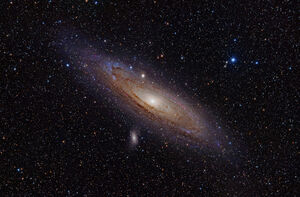| Andromeda Galaxy | |||||||||||||||||||||
|---|---|---|---|---|---|---|---|---|---|---|---|---|---|---|---|---|---|---|---|---|---|
| |||||||||||||||||||||
The Andromeda Galaxy is a spiral galaxy approximately 2.5 million light-years (2.4×1019 km) from Earth[1] in the Andromeda constellation. Also known as Messier 31, M31, or NGC 224, it is often referred to as the Great Andromeda Nebula in older texts. The Andromeda Galaxy is the nearest spiral galaxy to our Milky Way galaxy, but not the closest galaxy overall. It gets its name from the area of the sky in which it appears, the constellation of Andromeda, which was named after the mythological princess Andromeda. The Andromeda Galaxy is the largest galaxy of the Local Group, which also contains the Milky Way, the Triangulum Galaxy, and about 30 other smaller galaxies. Although the largest, the Andromeda Galaxy may not be the most massive, as recent findings suggest that the Milky Way contains more dark matter and could be the most massive in the grouping.[2] The 2006 observations by the Spitzer Space Telescope revealed that M31 contains one trillion (1012) stars:[3] at least twice the number of stars in the Milky Way galaxy, which is estimated to be 200–400 billion.[4]
The Andromeda Galaxy is estimated to be 7.1×1011 solar masses.[5] In comparison a 2009 study estimated that the Milky Way and M31 are about equal in mass,[6] while a 2006 study put the mass of the Milky Way at ~80% of the mass of the Andromeda Galaxy. The two galaxies are expected to collide in 3.75 billion years, eventually merging to form a giant elliptical galaxy.[7]
At an apparent magnitude of 3.4, the Andromeda Galaxy is one of the brightest Messier objects,[8] making it visible to the naked eye on moonless nights even when viewed from areas with moderate light pollution. Although it appears more than six times as wide as the full Moon when photographed through a larger telescope, only the brighter central region is visible to the naked eye or when viewed using binoculars or a small telescope.
Observation history[]
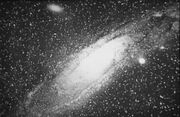
Great Andromeda Nebula by Isaac Roberts
The Persian astronomer Abd al-Rahman al-Sufi wrote a tantalizing line about the chained constellation in his Book of Fixed Stars around 964, describing it as a "small cloud".[9][10] Star charts of that period have it labeled as the Little Cloud.[10] The first description of the object based on telescopic observation was given by German astronomer Simon Marius on December 15, 1612.[11] Charles Messier catalogued it as object M31 in 1764 and incorrectly credited Marius as the discoverer, unaware of Al Sufi's earlier work. In 1785, the astronomer William Herschel noted a faint reddish hue in the core region of the M31. He believed it to be the nearest of all the "great nebulae" and based on the colour and magnitude of the nebula, he incorrectly guessed that it was no more than 2,000 times the distance of Sirius.
William Huggins in 1864 observed the spectrum of M31 and noted that it differed from a gaseous nebula.[12] The spectra of M31 displayed a continuum of frequencies, superimposed with dark absorption lines that help identify the chemical composition of an object. The Andromeda nebula was very similar to the spectra of individual stars, and from this it was deduced that M31 had a stellar nature. In 1885, a supernova (known as S Andromedae) was seen in M31, the first and so far only one observed in that galaxy. At the time M31 was considered to be a nearby object, so the cause was thought to be a much less luminous and unrelated event called a nova, and was named accordingly "Nova 1885".[13]
The first photographs of M31 were taken in 1887 by Isaac Roberts from his private observatory in Sussex, England. The long-duration exposure allowed the spiral structure of the galaxy to be seen for the first time.[14] However, at the time this object was still commonly believed to be a nebula within our galaxy, and Roberts mistakenly believed that M31 and similar spiral nebulae were actually solar systems being formed, with the satellites nascent planets[citation needed]. The radial velocity of this object with respect to our solar system was measured in 1912 by Vesto Slipher at the Lowell Observatory, using spectroscopy. The result was the largest velocity recorded at that time, at 69, moving in the direction of the Sun.[15]
Island universe[]
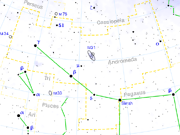
Location of M31 in the Andromeda constellation
In 1917, American astronomer Heber Curtis observed a nova within M31. Searching the photographic record, 11 more novae were discovered. Curtis noticed that these novae were, on average, 10 magnitudes fainter than those that occurred elsewhere in the sky. As a result he was able to come up with a distance estimate of 69. He became a proponent of the so-called "island universes" hypothesis, which held that spiral nebulae were actually independent galaxies.[16]
In 1920, the Great Debate between Harlow Shapley and Curtis took place, concerning the nature of the Milky Way, spiral nebulae, and the dimensions of the universe. To support his claim that the Great Andromeda Nebula (M31) was an external galaxy, Curtis also noted the appearance of dark lanes resembling the dust clouds in our own Galaxy, as well as the significant Doppler shift. In 1922 Ernst Öpik presented a very elegant and simple astrophysical method to estimate the distance of M31. His result put the Andromeda Nebula far outside our Galaxy at a distance of about 450,000 parsec, which is about 1,500,000 ly.[17] Edwin Hubble settled the debate in 1925 when he identified extragalactic Cepheid variable stars for the first time on astronomical photos of M31. These were made using the 2.5-metre (100-in) Hooker telescope, and they enabled the distance of Great Andromeda Nebula to be determined. His measurement demonstrated conclusively that this feature was not a cluster of stars and gas within our Galaxy, but an entirely separate galaxy located a significant distance from our own.[18]
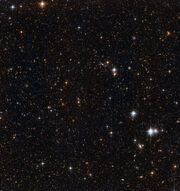
Stars in the Andromeda Galaxy's disc[19]
M31 plays an important role in galactic studies, since it is the nearest spiral galaxy (although not the nearest galaxy). In 1943 Walter Baade was the first person to resolve stars in the central region of the Andromeda Galaxy. Based on his observations of this galaxy, he was able to discern two distinct populations of stars based on their metallicity, naming the young, high velocity stars in the disk Type I and the older, red stars in the bulge Type II. This nomenclature was subsequently adopted for stars within the Milky Way, and elsewhere. (The existence of two distinct populations had been noted earlier by Jan Oort.)[20] Dr. Baade also discovered that there were two types of Cepheid variables, which resulted in a doubling of the distance estimate to M31, as well as the remainder of the Universe.[21]
Radio emission from the Andromeda Galaxy was first detected by Hanbury Brown and Cyril Hazard at Jodrell Bank Observatory using the 218-ft Transit Telescope, and was announced in 1950[22] (Earlier observations were made by radio astronomy pioneer Grote Reber in 1940, but were inconclusive, and were later shown to be an order of magnitude too high). The first radio maps of the galaxy were made in the 1950s by John Baldwin and collaborators at the Cambridge Radio Astronomy Group.[23] The core of the Andromeda Galaxy is called 2C 56 in the 2C radio astronomy catalogue. In 2009, the first planet may have been discovered in the Andromeda Galaxy. This candidate was detected using a technique called microlensing, which is caused by the deflection of light by a massive object.[24]
General[]
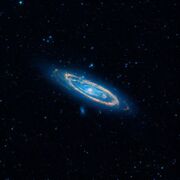
The Andromeda Galaxy as seen by NASA's Wide-field Infrared Survey Explorer
The measured distance to the Andromeda Galaxy was doubled in 1953 when it was discovered that there is another, dimmer type of Cepheid. In the 1990s, measurements of both standard red giants as well as red clump stars from the Hipparcos satellite measurements were used to calibrate the Cepheid distances.[25][26]
Formation and History[]
According to a team of astronomers reporting in 2010, M31 was formed out of the collision of two smaller galaxies between 5 and 9 billion years ago.[27]
A paper published in 2012[28] has outlined M31's basic history since its birth. According to it, Andromeda was born roughly 10 billion years ago from the merger of many smaller protogalaxies, leading to a galaxy smaller than the one we see today.
The most important event in M31's past history was the merger mentioned above that took place 8 billion years ago. This violent collision formed most of its (metal-rich) galactic halo and extended disk and during that epoch Andromeda's star formation would be very high, to the point of becoming a Luminous infrared galaxy for roughly 100 millon years.
2–4 billion years ago, M31 and the Triangulum Galaxy (M33) had a very close passage. This event produced high levels of star formation across the Andromeda Galaxy's disk – even some globular clusters – and disturbed M33's outer disk.
While there has been activity during the last 2 billion years, this has been much lower than during the past. There have been interactions with satellite galaxies like M32, M110, or others that have already disappeared absorbed by M31 that have formed structures like Andromeda's Giant Stellar Stream and a merger roughly 100 million years ago that is behind a counter-rotating disk of gas found in the center of M31 as well as the presence there of a relatively young (100 million years) stellar population. During this epoch, star formation through M31's disk decreased to the point of nearly shutting down to increasing again relatively recently.
Recent distance estimate[]
At least four distinct techniques have been used to measure distances to the Andromeda Galaxy.
In 2003, using the infrared surface brightness fluctuations (I-SBF) and adjusting for the new period-luminosity value of Freedman et al. 2001 and using a metallicity correction of −0.2 mag dex−1 in (O/H), an estimate of 69 was derived.
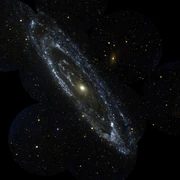
The Andromeda Galaxy pictured in ultraviolet light by GALEX
Using the Cepheid variable method, an estimate of 2.51 ± 0.13 Mly (770 ± 40 kpc) was reported in 2004.[5][29]
In 2005 Ignasi Ribas (CSIC, Institute for Space Studies of Catalonia (IEEC)) and colleagues announced the discovery of an eclipsing binary star in the Andromeda Galaxy. The binary star, designated M31VJ00443799+4129236,Template:Efn has two luminous and hot blue stars of types O and B. By studying the eclipses of the stars, which occur every 3.54969 days, the astronomers were able to measure their sizes. Knowing the sizes and temperatures of the stars, they were able to measure the absolute magnitude of the stars. When the visual and absolute magnitudes are known, the distance to the star can be measured. The stars lie at a distance of 69 and the whole Andromeda Galaxy at about 69.[1] This new value is in excellent agreement with the previous, independent Cepheid-based distance value.
M31 is close enough that the Tip of the Red Giant Branch (TRGB) method may also be used to estimate its distance. The estimated distance to M31 using this technique in 2005 yielded 69.[30]
Averaged together, all these distance measurements give a combined distance estimate of 69.Template:Efn Based upon the above distance, the diameter of M31 at the widest point is estimated to be 69.Template:Efn Applying trigonometry (arctangent), that figures to extending at an apparent 3.18° angle in the sky.
Mass and luminosity estimates[]
Mass estimates for the Andromeda Galaxy's halo (including dark matter) give a value of approximately 1.23×1012 M☉[31] (or 1.2 trillion solar masses) compared to 1.9×1012 M☉ for the Milky Way. Thus M31 may be less massive than our own galaxy, although the error range is still too large to say for certain. Even so, the masses of the Milky Way and M31 are comparable, and M31's spheroid actually has a higher stellar density than that of the Milky Way.[32]
In particular, M31 appears to have significantly more common stars than the Milky Way, and the estimated luminosity of M31, ~2.6×1010 L☉, is about 25% higher than that of our own galaxy.[33] However the rate of star formation in the Milky Way is much higher, with M31 producing only about one solar mass per year compared to 3–5 solar masses for the Milky Way. The rate of supernovae in the Milky Way is also double that of M31.[34] This suggests that M31 once experienced a great star formation phase, but is now in a relative state of quiescence, whereas the Milky Way is experiencing more active star formation.[33] Should this continue, the luminosity in the Milky Way may eventually overtake that of M31.
Error: No valid link was found at the end of line 22.
Structure[]

The Andromeda Galaxy seen in infrared by the Spitzer Space Telescope, one of NASA's four Great Space Observatories
Image of the Andromeda Galaxy taken by Spitzer in infrared, 24 micrometres (Credit:NASA/JPL–Caltech/K. Gordon, University of Arizona)
A Swift Tour of Andromeda Galaxy
A Galaxy Evolution Explorer image of the Andromeda Galaxy. The bands of blue-white making up the galaxy's striking rings are neighborhoods that harbor hot, young, massive stars. Dark blue-grey lanes of cooler dust show up starkly against these bright rings, tracing the regions where star formation is currently taking place in dense cloudy cocoons.When observed in visible light, Andromeda’s rings look more like spiral arms. The ultraviolet view shows that these arms more closely resemble the ring-like structure previously observed in infrared wavelengths with NASA’s Spitzer Space Telescope. Astronomers using Spitzer interpreted these rings as evidence that the galaxy was involved in a direct collision with its neighbor, M32, more than 200 million years ago.
Based on its appearance in visible light, the Andromeda Galaxy is classified as an SA(s)b galaxy in the de Vaucouleurs–Sandage extended classification system of spiral galaxies.[35] However, data from the 2MASS survey showed that the bulge of M31 has a box-like appearance, which implies that the galaxy is actually a barred spiral galaxy like the Milky Way, with the Andromeda Galaxy's bar viewed almost directly along its long axis.[36]
In 2005, astronomers used the Keck telescopes to show that the tenuous sprinkle of stars extending outward from the galaxy is actually part of the main disk itself.[37] This means that the spiral disk of stars in M31 is three times larger in diameter than previously estimated. This constitutes evidence that there is a vast, extended stellar disk that makes the galaxy more than 69 in diameter. Previously, estimates of the Andromeda Galaxy's size ranged from 69 across.
The galaxy is inclined an estimated 77° relative to the Earth (where an angle of 90° would be viewed directly from the side). Analysis of the cross-sectional shape of the galaxy appears to demonstrate a pronounced, S-shaped warp, rather than just a flat disk.[38] A possible cause of such a warp could be gravitational interaction with the satellite galaxies near M31. The galaxy M33 could be responsible for some warp in M31's arms, though more precise distances and radial velocities are required.
Spectroscopic studies have provided detailed measurements of the rotational velocity of M31 at various radii from the core. In the vicinity of the core, the rotational velocity climbs to a peak of 69 at a radius of 69, then descends to a minimum at 69 where the rotation velocity may be as low as 69. Thereafter the velocity steadily climbs again out to a radius of 69, where it reaches a peak of 69. The velocities slowly decline beyond that distance, dropping to around 69 at 69. These velocity measurements imply a concentrated mass of about 6×109 M☉ in the nucleus. The total mass of the galaxy increases linearly out to 69, then more slowly beyond that radius.[39]
The spiral arms of M31 are outlined by a series of H II regions that Baade described as resembling "beads on a string". They appear to be tightly wound, although they are more widely spaced than in our galaxy.[40] Rectified images of the galaxy show a fairly normal spiral galaxy with the arms wound up in a clockwise direction. There are two continuous trailing arms that are separated from each other by a minimum of about 69. These can be followed outward from a distance of roughly 69 from the core. The most likely cause of the spiral pattern is thought to be interaction with galaxy M32. This can be seen by the displacement of the neutral hydrogen clouds from the stars.[41]
In 1998, images from the European Space Agency's Infrared Space Observatory demonstrated that the overall form of the Andromeda Galaxy may be transitioning into a ring galaxy. The gas and dust within M31 is generally formed into several overlapping rings, with a particularly prominent ring formed at a radius of 69 from the core.[42] This ring is hidden from visible light images of the galaxy because it is composed primarily of cold dust.
Close examination of the inner region of M31 showed a smaller dust ring that is believed to have been caused by the interaction with M32 more than 200 million years ago. Simulations show that the smaller galaxy passed through the disk of the galaxy in Andromeda along the latter's polar axis. This collision stripped more than half the mass from the smaller M32 and created the ring structures in M31.[43]
Studies of the extended halo of M31 show that it is roughly comparable to that of the Milky Way, with stars in the halo being generally "metal-poor", and increasingly so with greater distance.[32] This evidence indicates that the two galaxies have followed similar evolutionary paths. They are likely to have accreted and assimilated about 1–200 low-mass galaxies during the past 12 billion years.[44] The stars in the extended halos of M31 and the Milky Way may extend nearly one-third the distance separating the two galaxies.
Nucleus[]
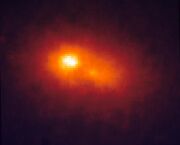
HST image of the Andromeda Galaxy core showing possible double structure. NASA/ESA photo
M31 is known to harbor a dense and compact star cluster at its very center. In a large telescope it creates a visual impression of a star embedded in the more diffuse surrounding bulge. The luminosity of the nucleus is in excess of the most luminous globular clusters.[citation needed]
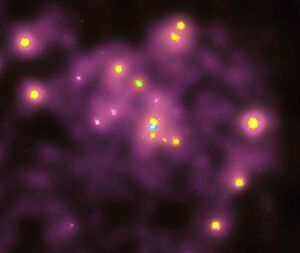
Chandra X-ray telescope image of the center of M31. A number of X-ray sources, likely X-ray binary stars, within Andromeda's central region appear as yellowish dots. The blue source at the center is at the position of the supermassive black hole.
In 1991 Tod R. Lauer used WFPC, then on board the Hubble Space Telescope, to image M31's inner nucleus. The nucleus consists of two concentrations separated by 69. The brighter concentration, designated as P1, is offset from the center of the galaxy. The dimmer concentration, P2, falls at the true center of the galaxy and contains a black hole measured at 3–5 × 107 M☉ in 1993,[45] and at 1.1–2.3 × 108 M☉ in 2005.[46] The velocity dispersion of material around it is measured to be ≈ 160 km/s.[47]
Scott Tremaine has proposed that the observed double nucleus could be explained if P1 is the projection of a disk of stars in an eccentric orbit around the central black hole.[48] The eccentricity is such that stars linger at the orbital apocenter, creating a concentration of stars. P2 also contains a compact disk of hot, spectral class A stars. The A stars are not evident in redder filters, but in blue and ultraviolet light they dominate the nucleus, causing P2 to appear more prominent than P1.[49]
While at the initial time of its discovery it was hypothesized that the brighter portion of the double nucleus was the remnant of a small galaxy "cannibalized" by M31,[50] this is no longer considered a viable explanation, largely because such a nucleus would have an exceedingly short lifetime due to tidal disruption by the central black hole. While this could be partially resolved if P1 had its own black hole to stabilize it, the distribution of stars in P1 does not suggest that there is a black hole at its center.[48]
Discrete sources[]
Artist's concept of the Andromeda Galaxy core showing a view across a disk of young, blue stars encircling a supermassive black hole. NASA/ESA photo
Apparently, by late 1968, no X-rays had been detected from the Andromeda Galaxy.[51] A balloon flight on October 20, 1970, set an upper limit for detectable hard X-rays from M31.[52]
Multiple X-ray sources have since been detected in the Andromeda Galaxy, using observations from the ESA's XMM-Newton orbiting observatory. Robin Barnard et al. hypothesized that these are candidate black holes or neutron stars, which are heating incoming gas to millions of kelvins and emitting X-rays. The spectrum of the neutron stars is the same as the hypothesized black holes, but can be distinguished by their masses.[53]
There are approximately 460 globular clusters associated with the Andromeda Galaxy.[54] The most massive of these clusters, identified as Mayall II, nicknamed Globular One, has a greater luminosity than any other known globular cluster in the Local Group of galaxies.[55] It contains several million stars, and is about twice as luminous as Omega Centauri, the brightest known globular cluster in the Milky Way. Globular One (or G1) has several stellar populations and a structure too massive for an ordinary globular. As a result, some consider G1 to be the remnant core of a dwarf galaxy that was consumed by M31 in the distant past.[56] The globular with the greatest apparent brightness is G76 which is located in the south-west arm's eastern half.[10] Another massive globular cluster -named 037-B327-, discovered in 2006 as is heavily reddened by the Andromeda Galaxy's interstellar dust, was thought to be more massive than G1 and the largest cluster of the Local Group;[57] however other studies have shown is actually similar in properties to G1.[58]
Unlike the globular clusters of the Milky Way, that show a relatively low age dispersion, Andromeda's globular clusters have a much larger range of ages: from systems as old as the galaxy itself to much younger systems, with ages between a few hundred million years to five billion years[59]
In 2005, astronomers discovered a completely new type of star cluster in M31. The new-found clusters contain hundreds of thousands of stars, a similar number of stars that can be found in globular clusters. What distinguishes them from the globular clusters is that they are much larger–several hundred light-years across–and hundreds of times less dense. The distances between the stars are, therefore, much greater within the newly discovered extended clusters.[60]
In the year 2012, a microquasar, a radio burst emanating from a smaller black hole, was detected in the Andromeda Galaxy. The progenitor black hole was located near the galactic center and had about 10 . Discovered through a data collected by the ESA's XMM-Newton probe, and subsequently observed by NASA's Swift and Chandra, the Very Large Array, and the Very Long Baseline Array, the microquasar was the first observed within the Andromeda Galaxy and the first outside of the Milky Way Galaxy.[61]
Satellites[]
- Main article: Andromeda's satellite galaxies
Like the Milky Way, the Andromeda Galaxy has satellite galaxies, consisting of 14 known dwarf galaxies. The best known and most readily observed satellite galaxies are M32 and M110. Based on current evidence, it appears that M32 underwent a close encounter with M31 (Andromeda) in the past. M32 may once have been a larger galaxy that had its stellar disk removed by M31, and underwent a sharp increase of star formation in the core region, which lasted until the relatively recent past.[62]
M110 also appears to be interacting with M31, and astronomers have found in the halo of M31 a stream of metal-rich stars that appear to have been stripped from these satellite galaxies.[63] M110 does contain a dusty lane, which may indicate recent or ongoing star formation.[64]
In 2006 it was discovered that nine of these galaxies lie along a plane that intersects the core of the Andromeda Galaxy, rather than being randomly arranged as would be expected from independent interactions. This may indicate a common tidal origin for the satellites.[65]
Future collision with the Milky Way[]
- Main article: Andromeda–Milky Way collision
The Andromeda Galaxy is approaching the Milky Way at about 69 which is about 1.96 billion to 2.74 billion miles per year,[66] making it one of the few blueshifted galaxies. The Andromeda Galaxy and the Milky Way are thus expected to collide in about 4.5 billion years, although the details are uncertain since Andromeda's tangential velocity with respect to the Milky Way is known to only within about a factor of two.[67] A likely outcome of the collision is that the galaxies will merge to form a giant elliptical galaxy.[68] Such events are frequent among the galaxies in galaxy groups. The fate of the Earth and the Solar System in the event of a collision is currently unknown. If the galaxies do not merge, there is a small chance that the Solar System could be ejected from the Milky Way or join M31.[69]
See also[]

The Andromeda Galaxy on a German postage stamp of 1999
- Andromeda Nebula in fiction
- List of Messier objects
- List of galaxies
- New General Catalogue
- NGC 206 – the brightest star cloud in the Andromeda Galaxy
Notes[]
Template:Notes
References[]
- ↑ 1.0 1.1 Cite error: Invalid
<ref>tag; no text was provided for refs namedRibas2005 - ↑ Cite error: Invalid
<ref>tag; no text was provided for refs namedDarkMatter - ↑ Cite error: Invalid
<ref>tag; no text was provided for refs namedtrillion-stars - ↑ Cite error: Invalid
<ref>tag; no text was provided for refs namedFrommert & Kronberg 2005 - ↑ 5.0 5.1 Cite error: Invalid
<ref>tag; no text was provided for refs namedKarachentsevetal2006 - ↑ Cite error: Invalid
<ref>tag; no text was provided for refs namedCfA - ↑ Cite error: Invalid
<ref>tag; no text was provided for refs namedmilky-way-collide - ↑ Cite error: Invalid
<ref>tag; no text was provided for refs namedFrommert & Kronberg 2007 - ↑ Cite error: Invalid
<ref>tag; no text was provided for refs namedHenbest & Couper 1994 - ↑ 10.0 10.1 10.2 Cite error: Invalid
<ref>tag; no text was provided for refs namedNSOG - ↑ Cite error: Invalid
<ref>tag; no text was provided for refs namedAati - ↑ Cite error: Invalid
<ref>tag; no text was provided for refs namedHuggins & Miller 1864 - ↑ Cite error: Invalid
<ref>tag; no text was provided for refs namedBackhouse 1888 - ↑ Cite error: Invalid
<ref>tag; no text was provided for refs namedRoberts 1899 - ↑ Cite error: Invalid
<ref>tag; no text was provided for refs namedSlipher 1913 - ↑ Cite error: Invalid
<ref>tag; no text was provided for refs namedCurtis 1988 - ↑ Cite error: Invalid
<ref>tag; no text was provided for refs namedÖpik 1922 - ↑ Cite error: Invalid
<ref>tag; no text was provided for refs namedHubble 1929 - ↑ Cite error: Invalid
<ref>tag; no text was provided for refs namedspacetelescope 2011-07-21 - ↑ Cite error: Invalid
<ref>tag; no text was provided for refs namedBaade 1944 - ↑ Cite error: Invalid
<ref>tag; no text was provided for refs namedGribbin 2001 - ↑ Cite error: Invalid
<ref>tag; no text was provided for refs namedBrown & Hazard 1950–51 - ↑ Cite error: Invalid
<ref>tag; no text was provided for refs namedvan der Kruit & Allen 1976 - ↑ Cite error: Invalid
<ref>tag; no text was provided for refs namedIngrosso 2009 - ↑ Cite error: Invalid
<ref>tag; no text was provided for refs namedHolland 1998 - ↑ Cite error: Invalid
<ref>tag; no text was provided for refs namedMoskvitch 2010 - ↑ (2012). "The Recent Stellar Archeology of M31 – The Nearest Red Disk Galaxy". The Astrophysical Journal 751 (1): 74. DOI:10.1088/0004-637X/751/1/74.
- ↑ Cite error: Invalid
<ref>tag; no text was provided for refs namedkarachentsevetal2004 - ↑ Cite error: Invalid
<ref>tag; no text was provided for refs namedMcConnachieetal2005 - ↑ Cite error: Invalid
<ref>tag; no text was provided for refs namedEvans - ↑ 32.0 32.1 Cite error: Invalid
<ref>tag; no text was provided for refs namedKalirai et al 2006 - ↑ 33.0 33.1 Cite error: Invalid
<ref>tag; no text was provided for refs namedvdb - ↑ Cite error: Invalid
<ref>tag; no text was provided for refs namedLiller & Mayer 1987 - ↑ Cite error: Invalid
<ref>tag; no text was provided for refs namedned - ↑ Cite error: Invalid
<ref>tag; no text was provided for refs namedBeaton 2006 - ↑ Cite error: Invalid
<ref>tag; no text was provided for refs namedChapman et al 2006 - ↑ Cite error: Invalid
<ref>tag; no text was provided for refs namedUC Santa Cruz 2001 - ↑ Cite error: Invalid
<ref>tag; no text was provided for refs namedRubin & Ford 1970 - ↑ Cite error: Invalid
<ref>tag; no text was provided for refs namedArp 1964 - ↑ Cite error: Invalid
<ref>tag; no text was provided for refs namedBraun 1991 - ↑ Cite error: Invalid
<ref>tag; no text was provided for refs namedESA 1998-10-14 - ↑ Cite error: Invalid
<ref>tag; no text was provided for refs namedHarvard-Smithsonian 2006-10-18 - ↑ Cite error: Invalid
<ref>tag; no text was provided for refs namedBullock & Johnston 2005 - ↑ Cite error: Invalid
<ref>tag; no text was provided for refs namedLauer - ↑ Cite error: Invalid
<ref>tag; no text was provided for refs namedBender et al 2005 - ↑ Cite error: Invalid
<ref>tag; no text was provided for refs namedGebhardt et al 2000 - ↑ 48.0 48.1 Cite error: Invalid
<ref>tag; no text was provided for refs namedTremaine 1995 - ↑ Cite error: Invalid
<ref>tag; no text was provided for refs namedhubblesite 1993-07-20 - ↑ Cite error: Invalid
<ref>tag; no text was provided for refs namedSchewe & Stein 1993 - ↑ Cite error: Invalid
<ref>tag; no text was provided for refs namedFujimoto et al 1969 - ↑ Cite error: Invalid
<ref>tag; no text was provided for refs namedPeterson 1973 - ↑ Cite error: Invalid
<ref>tag; no text was provided for refs namedBarnard Kolb & Osborne 2005 - ↑ Cite error: Invalid
<ref>tag; no text was provided for refs namedBarmby & Huchra 2001 - ↑ Cite error: Invalid
<ref>tag; no text was provided for refs namedhubblesite 1996-04-24 - ↑ Cite error: Invalid
<ref>tag; no text was provided for refs namedMeylan et al 2001 - ↑ Ma, J.; de Grijs, R.; Yang, Y.; Zhou, X.; Chen, J.; Jiang, Z.; Wu, Z.; Wu, J. (2006). "A 'super' star cluster grown old: the most massive star cluster in the Local Group". Monthly Notices of the Royal Astronomical Society 368 (3): 1443. DOI:10.1111/j.1365-2966.2006.10231.x.
- ↑ Cohen, Judith G. (2006). "The Not So Extraordinary Globular Cluster 037-B327 in M31". The Astrophysical Journal 653: L21–L23. DOI:10.1086/510384.
- ↑ Burstein, David; Li, Yong; Freeman, Kenneth C.; Norris, John E.; Bessell, Michael S.; Bland-Hawthorn, Joss; Gibson, Brad K.; Beasley, Michael A.; Lee, Hyun-chul; Barbuy, Beatriz; Huchra, John P.; Brodie, Jean P.; Forbes, Duncan A. (2004). "Globular Cluster and Galaxy Formation: M31, the Milky Way, and Implications for Globular Cluster Systems of Spiral Galaxies". Astrophysical Journal 614: 158–166. DOI:10.1086/423334.
- ↑ Cite error: Invalid
<ref>tag; no text was provided for refs namedHuxor et al 2005 - ↑ Prostak, Sergio, "Microquasar in Andromeda Galaxy Amazes Astronomers", 2012-12-14.
- ↑ Cite error: Invalid
<ref>tag; no text was provided for refs namedBekki et al 2001 - ↑ Cite error: Invalid
<ref>tag; no text was provided for refs namedIbata et al 2001 - ↑ Cite error: Invalid
<ref>tag; no text was provided for refs namedYoung 2000 - ↑ Cite error: Invalid
<ref>tag; no text was provided for refs namedKoch & Grebel 2006 - ↑ Cite error: Invalid
<ref>tag; no text was provided for refs namedMalik 2002 - ↑ Cite error: Invalid
<ref>tag; no text was provided for refs namedThe Sky At Night 2007-11-05 - ↑ Cite error: Invalid
<ref>tag; no text was provided for refs namedCox & Loeb 2008 - ↑ Cite error: Invalid
<ref>tag; no text was provided for refs namedCain 2007
External links[]
Template:Commons category
- The Andromeda Galaxy on WikiSky: DSS2, SDSS, GALEX, IRAS, Hydrogen α, X-Ray, Astrophoto, Sky Map, Articles and images
- StarDate: M31 Fact Sheet
- Simbad data on M31
- Messier 31, SEDS Messier pages
- Astronomy Picture of the Day
- A Giant Globular Cluster in M31 1998 October 17.
- M31: The Andromeda Galaxy 2004 July 18.
- Andromeda Island Universe 2005 December 22.
- Andromeda Island Universe 2010 January 9.
- WISE Infrared Andromeda 2010 February 19
- M31 and its central Nuclear Spiral
- Amateur photography – M31
- Globular Clusters in M31 at The Curdridge Observatory
- First direct distance to Andromeda − Astronomy magazine article
- Andromeda Galaxy at SolStation.com
- Andromeda Galaxy at The Encyclopedia of Astrobiology, Astronomy, & Spaceflight
- M31, the Andromeda Galaxy at NightSkyInfo.com
- Than, Ker, "Strange Setup: Andromeda's Satellite Galaxies All Lined Up", Space.com, January 23, 2006.
- Hubble Finds Mysterious Disk of Blue Stars Around Black Hole Hubble observations (Sep 20 2005) put the mass of the Andromeda core black hole at 140 million solar masses
- M31 (Apparent) Novae Page (IAU)
- Multi-wavelength composite
- Andromeda Project (crowd-source)
- Gray, Meghan; Szymanek, Nik; Merrifield, Michael. M31 – Andromeda Galaxy. Deep Sky Videos. Brady Haran.
